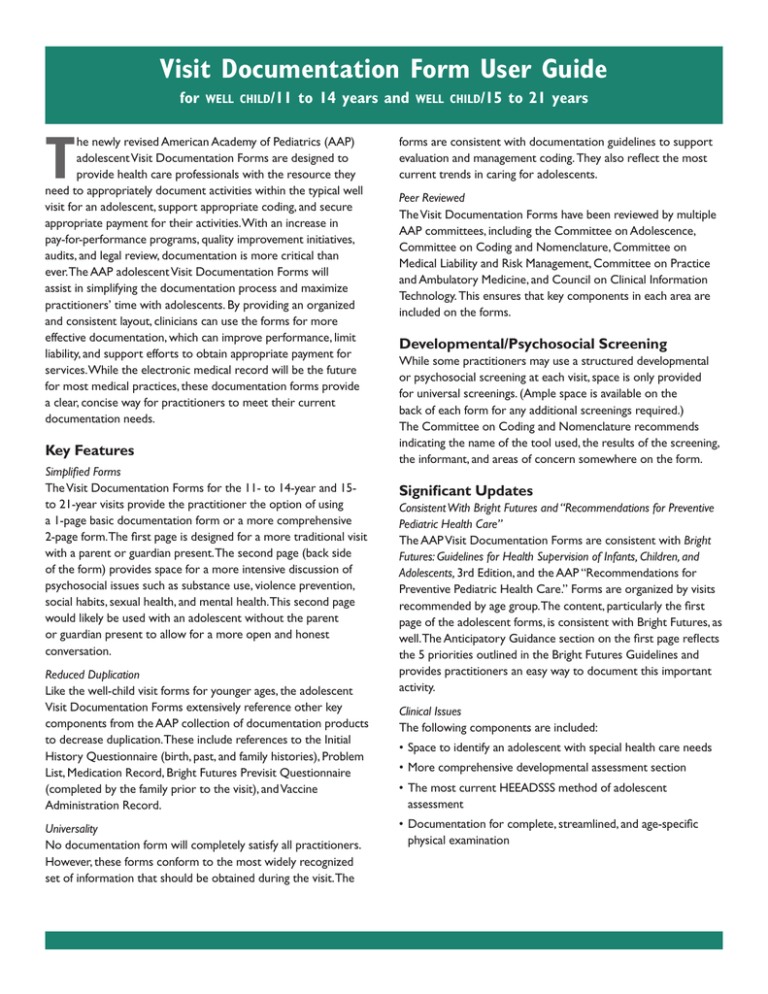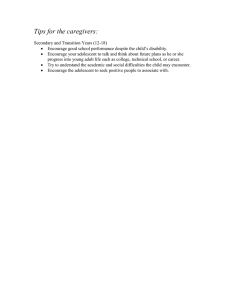
Visit Documentation Form User Guide
for
well child/11
to 14 years and
T
he newly revised American Academy of Pediatrics (AAP)
adolescent Visit Documentation Forms are designed to
provide health care professionals with the resource they
need to appropriately document activities within the typical well
visit for an adolescent, support appropriate coding, and secure
appropriate payment for their activities. With an increase in
pay-for-performance programs, quality improvement initiatives,
audits, and legal review, documentation is more critical than
ever. The AAP adolescent Visit Documentation Forms will
assist in simplifying the documentation process and maximize
practitioners’ time with adolescents. By providing an organized
and consistent layout, clinicians can use the forms for more
effective documentation, which can improve performance, limit
liability, and support efforts to obtain appropriate payment for
services. While the electronic medical record will be the future
for most medical practices, these documentation forms provide
a clear, concise way for practitioners to meet their current
documentation needs.
Key Features
Simplified Forms
The Visit Documentation Forms for the 11- to 14-year and 15to 21-year visits provide the practitioner the option of using
a 1-page basic documentation form or a more comprehensive
2-page form. The first page is designed for a more traditional visit
with a parent or guardian present. The second page (back side
of the form) provides space for a more intensive discussion of
psychosocial issues such as substance use, violence prevention,
social habits, sexual health, and mental health. This second page
would likely be used with an adolescent without the parent
or guardian present to allow for a more open and honest
conversation.
Reduced Duplication
Like the well-child visit forms for younger ages, the adolescent
Visit Documentation Forms extensively reference other key
components from the AAP collection of documentation products
to decrease duplication. These include references to the Initial
History Questionnaire (birth, past, and family histories), Problem
List, Medication Record, Bright Futures Previsit Questionnaire
(completed by the family prior to the visit), and Vaccine
Administration Record.
Universality
No documentation form will completely satisfy all practitioners.
However, these forms conform to the most widely recognized
set of information that should be obtained during the visit. The
well child/15
to 21 years
forms are consistent with documentation guidelines to support
evaluation and management coding. They also reflect the most
current trends in caring for adolescents.
Peer Reviewed
The Visit Documentation Forms have been reviewed by multiple
AAP committees, including the Committee on Adolescence,
Committee on Coding and Nomenclature, Committee on
Medical Liability and Risk Management, Committee on Practice
and Ambulatory Medicine, and Council on Clinical Information
Technology. This ensures that key components in each area are
included on the forms.
Developmental/Psychosocial Screening
While some practitioners may use a structured developmental
or psychosocial screening at each visit, space is only provided
for universal screenings. (Ample space is available on the
back of each form for any additional screenings required.)
The Committee on Coding and Nomenclature recommends
indicating the name of the tool used, the results of the screening,
the informant, and areas of concern somewhere on the form.
Significant Updates
Consistent With Bright Futures and “Recommendations for Preventive
Pediatric Health Care”
The AAP Visit Documentation Forms are consistent with Bright
Futures: Guidelines for Health Supervision of Infants, Children, and
Adolescents, 3rd Edition, and the AAP “Recommendations for
Preventive Pediatric Health Care.” Forms are organized by visits
recommended by age group. The content, particularly the first
page of the adolescent forms, is consistent with Bright Futures, as
well. The Anticipatory Guidance section on the first page reflects
the 5 priorities outlined in the Bright Futures Guidelines and
provides practitioners an easy way to document this important
activity.
Clinical Issues
The following components are included:
•Space to identify an adolescent with special health care needs
•More comprehensive developmental assessment section
•The most current HEEADSSS method of adolescent
assessment
•Documentation for complete, streamlined, and age-specific
physical examination
Visit Documentation Form User Guide
for
well child/11
ACCOMPANIED BY/INFORMANT
Conforms to
evaluation and
management
documentation
guidelines.
to 14 years and
PREFERRED LANGUAGE
DRUG ALLERGIES
WEIGHT (%)
BMI (%)
to 21 years
Name
DATE/TIME
Space for
nameplate imprint.
ID NUMBER
CURRENT MEDICATIONS
HEIGHT (%)
well child/15
BLOOD PRESSURE
BIRTH DATE
AGE
M
Visit with:
Teen alone
Parent(s) alone
Mother
Father
Teen with parents
History
Physical Examination
Previsit Questionnaire reviewed
Teen has a dental home
Follow-up on previous concerns
Interval history
None
= NL
Bright Futures Priority
SKIN
BACK/SPINE
BREASTS
GENITALIA
SEXUAL MATURITY RATING
Teen has special health care needs
None
Concerns and questions
References to
Initial History
Questionnaire,
Previsit
Questionnaire,
and Problem List
decrease need
to repeat perti­nent
information.
F
Other
Addressed (see other side)
None
Addressed (see other side)
Addressed (see other side)
Menarche: Age
Menstrual problems
Additional Systems
GENERAL APPEARANCE
HEAD
EYES
EARS
NOSE
MOUTH AND THROAT
NECK
TEETH
LUNGS
HEART
GI/ABDOMEN
EXTREMITIES
NEUROLOGIC
MUSCULOSKELETAL
Check boxes
with space for
additional findings.
Abnormal findings and comments
Regularity
Medication Record reviewed and updated
Social/Family History
See Initial History Questionnaire.
Changes since last visit
Teen lives with
Relationship with parents/siblings
Risk Assessment
Well teen
If not reviewed in Supplemental Questionnaire
(Use other side if risks identified.)
HOME
Yes
No
Eats meals with family
Has family member/adult to turn to for help
Yes
No
Is permitted and is able to make independent decisions
Yes
No
EDUCATION
Grade
Performance NL
Behavior/Attention NL
Homework NL
EATING
Eats regular meals including adequate fruits and vegetables
Yes
No
Yes
No
Drinks non-sweetened liquids
Calcium source
Yes
No
Has concerns about body or appearance
Yes
No
ACTIVITIES
Has friends
Yes
No
Yes
No
At least 1 hour of physical activity/day
Screen time (except for homework) less than 2 hours/day
Yes
No
Has interests/participates in community activities/volunteers
Yes
No
DRUGS (Substance use/abuse)
Uses tobacco/alcohol/drugs
Yes
No
SAFETY
Yes
No
Home is free of violence
Uses safety belts/safety equipment
Yes
No
Impaired/Distracted driving
Yes
No
Has relationships free of violence
Yes
No
SEX
Has had oral sex
Yes
No
Has had sexual intercourse (vaginal, anal)
Yes
No
SUICIDALITY/MENTAL HEALTH
Has ways to cope with stress
Yes
No
Displays self-confidence
Yes
No
Has problems with sleep
Yes
No
Gets depressed, anxious, or irritable/has mood swings
Yes
No
Has thought about hurting self or considered suicide
Yes
No
Uses most
current best
practices for
evaluation of
adolescents.
Check for well
teen and space
for additional
comments.
Assessment
No interval change
Anticipatory Guidance
Discussed and/or handout given
PHYSICAL GROWTH AND
DEVELOPMENT
Balanced diet
Physical activity
Limit TV
Protect hearing
Brush/Floss teeth
Regular dentist visits
SOCIAL AND ACADEMIC
COMPETENCE
Age-appropriate limits
Friends/relationships
Family time
Community involvement
Encourage reading/school
Rules/Expectations
Planning for after high school
EMOTIONAL WELL-BEING
Dealing with stress
Decision-making
Mood changes
Sexuality/Puberty
RISK REDUCTION
Tobacco, alcohol, drugs
Prescription drugs
Sex
VIOLENCE AND INJURY
PREVENTION
Seat belts
Guns
Conflict resolution
Driving restriction
Sports/Recreation safety
Plan
Immunizations (See Vaccine Administration Record.)
Vision
Cholesterol (18–21 years)
Laboratory/Screening results:
Referral to
Follow-up/Next visit
Allows for
documentation
of all methods of
communicating
informally.
Form aligned with
recommendations
in the Bright
Futures Guidelines,
3rd Edition.
See other side
Print Name
Signature
PROVIDER 1
PROVIDER 2
WELL CHILD/15
HE0499
to 21 years
The second side of these forms allows for a more
comprehensive evaluation of the adolescent. An
expanded version of the risk assessment section
on page 1 is used, with an additional section on
substance use.
The recommendations in this publication do not indicate an exclusive course of treatment or serve as
a standard of medical care. Variations, taking into account individual circumstances, may be appropriate.
Copyright © 2010 American Academy of Pediatrics. All rights reserved. No part of this publication may
be reproduced, stored in a retrieval system, or transmitted, in any form or by any means, electronic,
mechanical, photocopying, recording, or otherwise, without prior written permission from the publisher.
9-208





